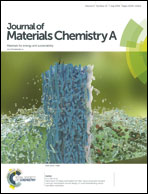Effect of donor length on electronic structures and charge transport polarity for DTDPP-based D–A copolymers: a computational study based on a super-exchange model†
Abstract
With the number of thiophene units increasing from 1 to 5 for dithiophenyldiketopyrrolopyrrole-(n-thiophene) (DTDPP-nT) polymers, we found that their band gap increases and their bandwidth narrows from first-principles computations; their transport polarity changes from n-type (n = 1, 2, 3) to ambipolar (n = 4) and finally to p-type (n = 5). The electronic structures and transport polarity can be understood from an intra-chain super-exchange (SE) mechanism. For different donor lengths, the SE model changed from sandwich-type (n = 1–4) to staggered-type (n = 5). As for n = 1–4, the charge transport polarity is determined with the relative magnitude of polarized LUMO and HOMO energy differences of the fragment (DTDPP/nT). In contrast, DTDPP-5T reveals p-type transport polarity due to the staggered-type SE mechanism. In addition, inter-chain coupling and band edge shift also contribute to the conversion of transport polarity.



 Please wait while we load your content...
Please wait while we load your content...